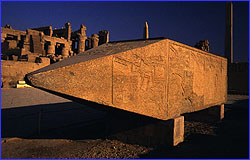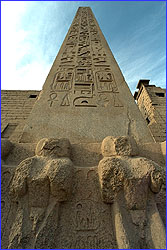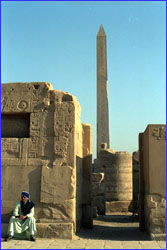
|
 |
 |
back to A World of Obelisks Location: Karnak Temple, Luxor Pharaoh: Hatshepsut (reigned 1503-1482 B.C.) Height: 97 feet Weight: 323 tons Story: Not long after her father Tuthmosis I died, leaving the throne to his young grandson Tuthmosis III, Hatshepsut declared herself "king." She erected four obelisks at Karnak, but only this one remains standing. On its base are 32 horizontal lines of hieroglyphs, eight to a side, that describe why she had the obelisk built. The inscription reads in part: "I was sitting in the palace and I remembered the One who created me; my heart directed me to make for him two obelisks of electrum [a natural alloy of gold and silver], that their pyramidions might mingle with the sky amid the august pillared hall between the great pylons of [Tuthmosis I]....My Majesty began work on them in Year 15, second month of Winter, day 1, continuing until Year 16, fourth month of Summer, day 30, making 7 months in cutting [them] from the mountain." Lest anyone doubt her sincerity, Hatshepsut went on to say, "I acted for him with a straightforward heart, as a king does for any god...Let not anyone who hears this say it is boasting which I have said, but rather say, 'How like her it is, she who is truthful to her father.' The god knows it in me [namely] Amun, Lord of the Thrones of the Two Lands...I am his daughter in very truth, who glorifies him."
Pharaoh: Ramses II (reigned 1304-1237 B.C.) Height: 82 feet Weight: 254 tons Story: Ramses II (the Great) erected more obelisks than any other pharaoh; in the ruins of the Delta city of Tanis alone, fully 23 obelisks or partial obelisks bearing his name have turned up. Most of Ramses' obelisks are relatively small, but the two that stood before Luxor Temple were quite large. One stands there today; the other was shipped off to Paris in the 18th century. Each of the four sides of the Luxor obelisk bear scenes of Ramses making offerings to the god Amun-Re, beneath which are three columns of inscriptions. On the northern face, the column on the right deems Ramses "splended of statues, great of monuments in the Southern Opet [Luxor]...making monuments in Thebes for the One." The left-hand column meanwhile, proclaims the pharaoh "the sovereign, great of Jubilees like Tatenen, making monuments in Karnak for his father Amun-Re who placed him upon his throne...." At the base of the obelisk, four stone baboons raise their front feet in adoration of the sun.
Pharaoh: Tuthmosis I (reigned 1525-c.1512 B.C.) Height: 66 feet Weight: 143 tons Story: Tuthmosis I was one of the great warrior-kings of ancient Egypt, extending his domains south into Nubia and north into Syria. He raised a pair of red-granite obelisks at Karnak, though only one remains standing today. In his tomb in the Theban necropolis, Aneni, one of the pharaoh's officials, relates how he "saw to the erection of two [great] obelisks...having built an august boat 120 cubits in length and 40 cubits in width in order to transport these obelisks." [One royal cubit = 1.72 feet] "They arrived safe and sound, and landed at Karnak." Typical of the hieroglyphic inscriptions on the obelisk are those of the west face, which relate that Tuthmosis I "made it as a monument for his father Amun-Re, foremost of the Two Lands, erecting for him two large obelisks at the double gate of the temple, the pyramidions being of [electrum]...." (Alas, the electrum is all gone today.) About 400 years after the obelisks were raised, Ramses IV added his own inscriptions on either side of those of Tuthmosis I. Back to A World of Obelisks Explore Ancient Egypt | Raising the Obelisk | Meet the Team Dispatches | Pyramids | E-Mail | Resources Classroom Resources | Site Map | Mysteries of the Nile Home Editor's Picks | Previous Sites | Join Us/E-mail | TV/Web Schedule About NOVA | Teachers | Site Map | Shop | Jobs | Search | To print PBS Online | NOVA Online | WGBH © | Updated November 2000 |
 Hatshepsut's two obelisks at Karnak: one fallen, one
still standing after nearly 3,500 years.
Hatshepsut's two obelisks at Karnak: one fallen, one
still standing after nearly 3,500 years.
 Sun-worshipping stone baboons crouch at the base of
Ramses the Great's obelisk at Luxor Temple.
Sun-worshipping stone baboons crouch at the base of
Ramses the Great's obelisk at Luxor Temple.
 Tuthmosis I's obelisk at Karnak used to be one of
four set up by the pharaoh and his grandson Tuthmosis
III.
Tuthmosis I's obelisk at Karnak used to be one of
four set up by the pharaoh and his grandson Tuthmosis
III.